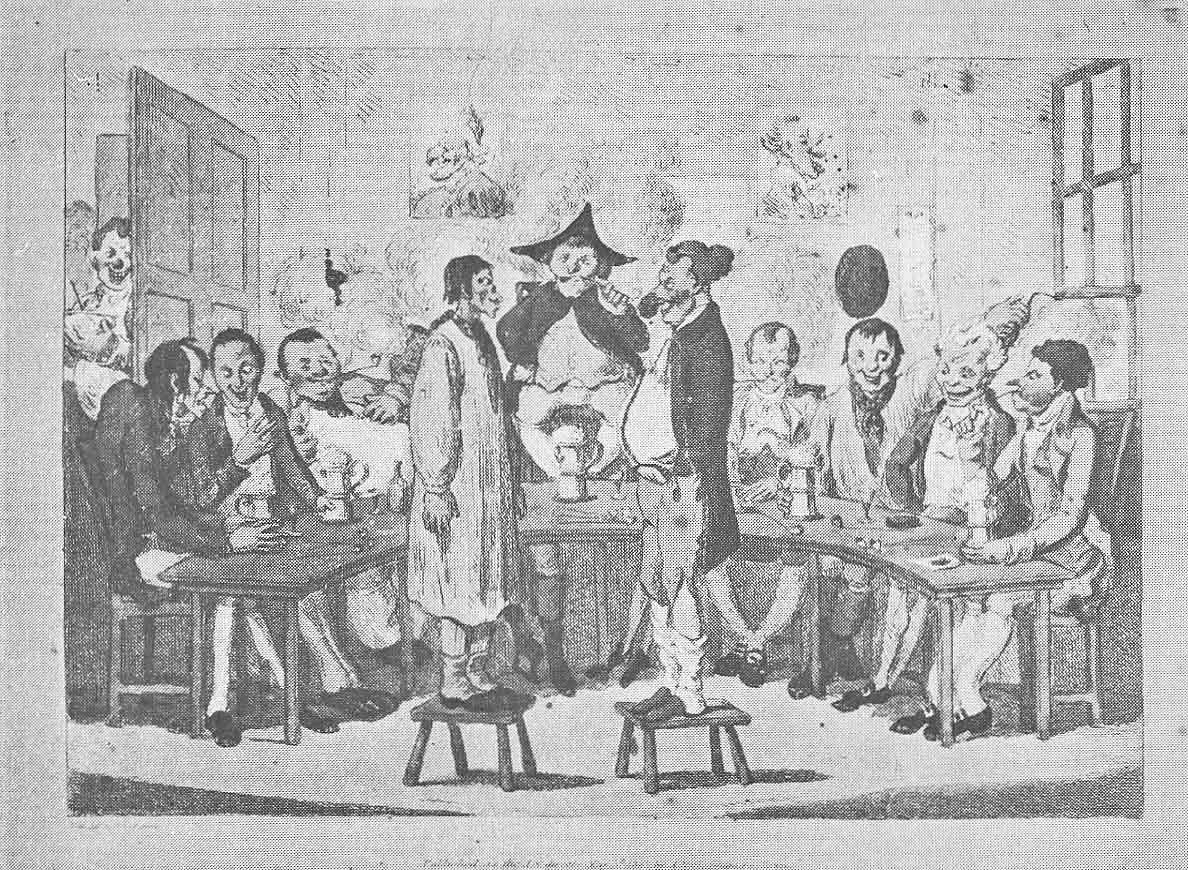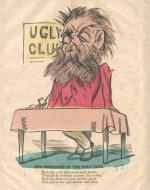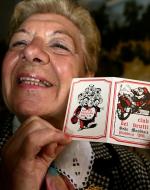Created by Brooke Berner on Mon, 05/02/2022 - 12:15
Description:
Introduction
In the Victorian Age, there was an emphasis on normalcy. Therefore, those who differed in appearance and ability were often mistreated and ostracized, as they were labeled as unproductive and ugly. However, those who were considered "ugly" decided to reclaim this label and form ugly clubs, where members were inducted based on their appearance and ranked based on who was the ugliest. Unfortunately, ugly clubs were mostly made up of disabled individuals who did not meet the Victorian standard of beauty and normalcy. Now, ugly clubs have taken on a new form and have evolved from the typical Victorian era ugly club. Similarly, the very standard of beauty and what "ugly" means has shifted. It is important to recognize the history of ugly clubs, their intersection with disabled individuals, and ugly clubs in today's society.
Howell, Edward. (1912). Ye Old Ugly Face Clubb, Leverpool, 1743-1753. Nineteenth Century Disability.
This features an advertisement from 1806 for the Liverpool Ugly Face Club's anniversary. There are approximately a dozen men gathered in this room, all of whom have noticeably ugly appearances. A majority of the men have facial deformities and unflattering features, like large noses, bulging eyes, and flat faces. While some of these features are natural, things like bulging eyes and flat faces are typical side effects of other disabilities, so the depictions of them allow viewers to assume some of these men were disabled. In addition, there are two men standing on stools in front of the rest of the members, one of whom is sickly thin and appears to be missing his nose. The other man is heavier and has a large, inflamed nose. This was a depiction of the two ugliest members facing off while the other members voted. Since it was an advertisement for an ugly club, it had to look appealing to potential members. Luckily, the advertisement shows a lot of the men laughing, talking, and drinking. However, the exaggerated expressions on the men's faces were an attempt to make them look dumb since many of these men suffered from disabilities. Again, this was during a time when little was known about disabilities, so it was assumed that they were morally and intellectually inept. Overall, the advertisement depicts the comradery ugly people had within these clubs, but reinforces the harmful idea of normalcy in the Victorian era.
McAllister, John. (between 1840 and 1880?). King of the Ugly Club. The Library Company of Philadelphia.
McAllister, John. (not before 1848). Queen of the Ugly Club. The Library Company of Philadelphia.
These satirical comics were used to poke fun at the nature of ugly clubs and their members. The first comic depicts the "King of the Ugly Club," who is a hairy man with a large nose. The caption underneath the caricature jokingly states that the more crows a person scares, the closer they are to becoming the president of the ugly club. The man's hairiness, which is the exaggerated feature of the comic, was a very common trait people associated with ugliness in this era. For example, freakshows made their livings off of preying on disabled individuals, some of whom played their role as the world's hairiest person. Ironically, this comic is reminiscent of these individuals and pokes fun at their appearance, despite the fact they had little say in joining the freakshow. While the comic focuses on ugly clubs and the people joining them, it is important to note that the very people it is making fun of were being abused by these freakshows. This comic was published in the era of freakshows, so ideally it wanted to humanize these individuals and persuade them to join their local ugly club.
The next comic depicts "The Queen of the Ugly Club," which is drawn in the same style as the other comic. This was a satirical and political cartoon poking fun at European monarchies and their appearances. The caption below the caricature reminds women, despite how ugly the European monarchs are, they will still reign queen of the ugly club. It is assumed this was published around 1848, which was during the time of revolts against monarchies within Europe. The cartoon itself is less about ugly clubs and more about the political climate of the time, where ugly clubs are simply used as the punchline. The drawing itself features a woman looking in a mirror while scowling. She appears to be older and has a larger nose and wrinkles. While unkind, this is not the worst depiction of a person involved in an ugly club and seemingly does not make fun of features a disabled person may have. This may indicate a shift in the beauty standard that emphasized youthfulness and femininity over normalcy.
Levine, Jon. (2019). Bruna Bressan holds up a membership card to the 'Ugly Club' in the town of Piobbico, Italy. The New York Post.
Now, there is a village in Italy that praises its ugliest citizens. Piobbico has celebrated ugliness since 1879, where it encourages residents to join "Club Dei Brutti," and celebrate their inner beauty. Every year on the first Sunday in September, the town of Piobbico holds the Festival of the Ugly, where a new president is elected and new members are instated. The emphasis of Club Dei Brutti and the Festival of the Ugly is not to focus on whether or not the individual is ugly, but to emphasize that beauty is only skin deep and to highlight other redeemable qualities. This is a vast difference from the Victorian Age ugly clubs that ensured that the members were as ugly as possible. Also, Victorian ugly clubs did not seem overly concerned with the quality of a person, since it was assumed that ugly and disabled people failed morally. Ultimately, 21st-century ugly clubs have evolved and work to promote the message of self-love.
Facebook. (2022). A group you can only join if you're ugly (we check).
Finally, ugly clubs have evolved to where they are accessible through social media. This Facebook group, titled, "A group you can only join if you're ugly (we check)," is a community in which people apply and moderators determine whether or not the applicants are ugly enough to participate. Within the group, people post pictures of themselves for other members to "roast," or playfully make fun of them. In general, the group is meant to be a fun, welcoming place filled with self-deprecating humor. This is similar to the vibe of the Victorian ugly clubs, where people went to socialize and make friends with other ugly people. The clear differences between the Facebook ugly club and Victorian ugly clubs are the accessibility and standards. The Facebook ugly club has a quick application process where a person can be accepted within minutes. For example, the author of this was accepted in 20 minutes. Also, the Facebook ugly club has different standards of ugly than people in the Victorian era. The aforementioned standard of normalcy is no longer the 21st-century beauty standard. Nowadays, the beauty standard is usually decided by popular culture. Therefore, no one has to be exceedingly ugly to join the Facebook group. Overall, the modern ugly clubs moved away from disproportionately hurting disabled people and instilled a sense of humor, lightheartedness, and positivity within the members.






